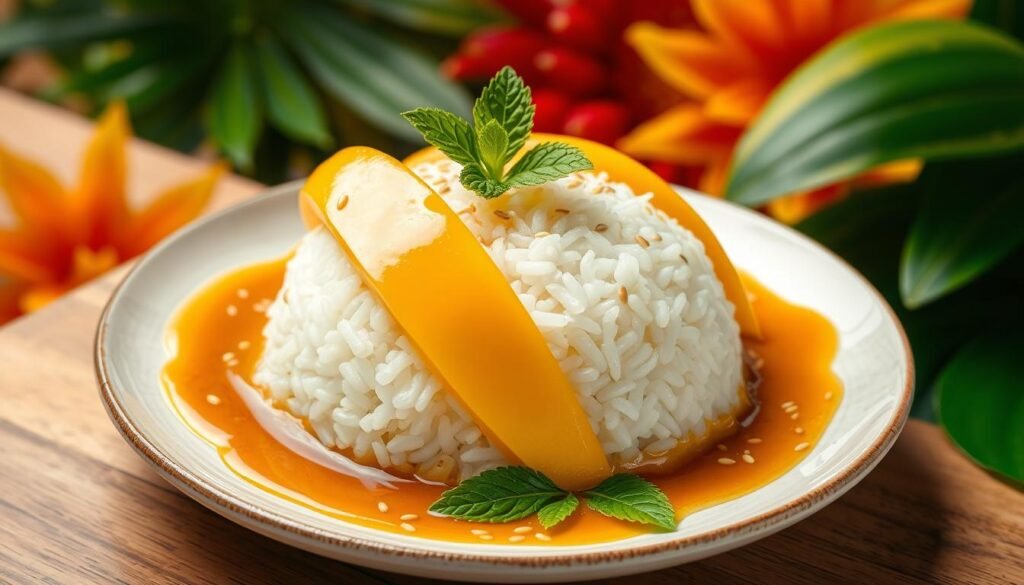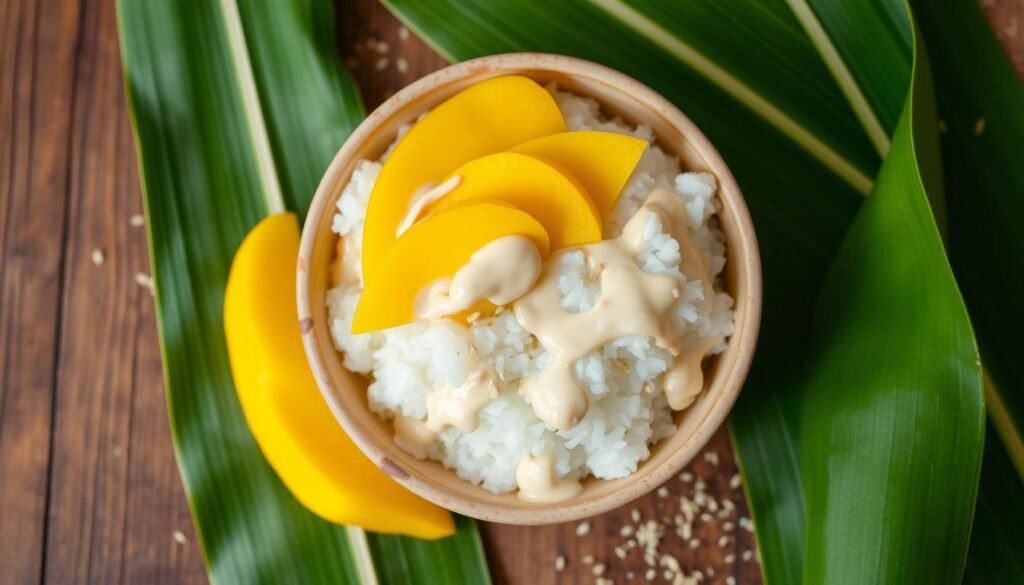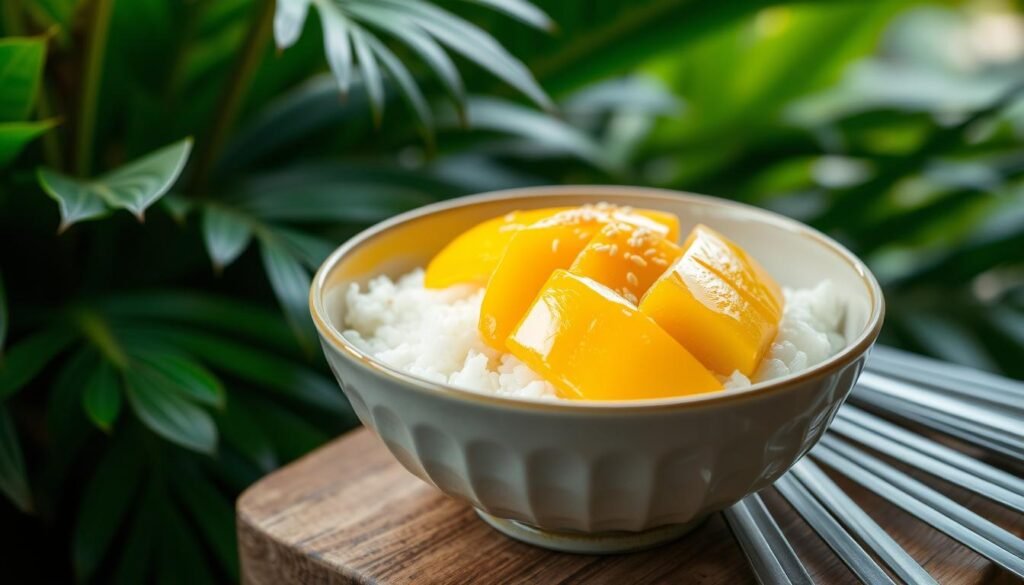I love Thai Mango Sticky Rice. It takes me to a sweet tropical place. This Thai dessert is sweet and savory, a must-try for a tropical treat.
Think of a warm summer day and you want something sweet. Thai Mango Sticky Rice is perfect. It has creamy coconut sauce and fragrant sticky rice. It’s a favorite in Thai cuisine.
I’m excited to share Thai Mango Sticky Rice with you. It’s special because of its cultural meaning, ingredients, and how it’s made. It’s a sweet escape for anyone wanting to try something new.
The Cultural Significance of Thai Mango Sticky Rice
Thai Mango Sticky Rice is very special in Thai culture. It’s not just a yummy dessert. It also shows hospitality, generosity, and community.
This dish is a big part of Thai culture. It’s made with special ingredients like glutinous rice, fresh mango, and coconut milk. These ingredients make a sweet and creamy flavor that everyone loves.
Food is very important in Thai culture. It brings people together. Mango sticky rice is often at the center of these gatherings.
It’s a dish that shows love, care, and hospitality. Its presence at special occasions reminds us of the importance of community and tradition in Thai cuisine.
| Ingredient | Significance in Thai Cuisine |
|---|---|
| Glutinous Rice | Symbol of hospitality and generosity |
| Fresh Mango | Representing sweetness and abundance |
| Coconut Milk | Adding creaminess and richness to the dish |
Mango sticky rice is more than a dessert. It’s a symbol of community, hospitality, and tradition. It brings people together and creates lasting memories.
Essential Ingredients for Authentic Thai Mango Sticky Rice
To make real Thai Mango Sticky Rice, you need the right stuff. It’s got glutinous rice, fresh mango, and coconut milk. These ingredients make the dish taste and feel like it’s from Thailand.
The rice is key because it soaks up the coconut milk well. You also need fresh mango for sweetness and color. Coconut milk makes it creamy and rich.
Other things like sugar, salt, and pandan leaves can make it even better. But the main ingredients are what make it special. Using these right, you can make a dessert that’s both tasty and traditional.
| Ingredient | Importance |
|---|---|
| Glutinous Rice | Absorbs coconut milk, provides texture |
| Fresh Mango | Natural sweetness, flavor, and color |
| Coconut Milk | Creaminess, richness, and flavor |
Selecting and Preparing the Perfect Mango
To make a real Thai Mango Sticky Rice, you need the right mango. Look for mangoes that are soft and smell sweet. The best color is yellow or orange.
There are many mango types to pick from. Chaunsa, Ataulfo, and Haden are popular. Each tastes different, so try a few to find your favorite. For Thai Sticky Rice, choose a sweet and tangy one.
After picking the mango, it’s time to cut it right. Slice it thin, removing the pit and skin. This makes sure it cooks well and tastes great with the rice. Learning to pick and cut mangoes right makes your dish amazing.
Choosing Ripe Mangoes
It’s key to pick ripe mangoes for the best taste and feel. Check by squeezing it gently and smelling it for sweetness.
Different Mango Varieties to Use
Each mango type brings its own taste and feel. Chaunsa mangoes are sweet and tangy. Ataulfo mangoes are creamy.
Proper Cutting Techniques
Cutting the mango right is important. Slice it thin, removing the pit and skin. This way, it cooks evenly and mixes well with the rice.
The Right Type of Rice and Why It Matters
Choosing the right rice is key for Thai Mango Sticky Rice. Sticky rice, also known as glutinous or sweet rice, is the best choice. It’s sticky and perfect for soaking up the coconut sauce.
Sticky rice balances the dish’s flavors and textures. It has more starch than regular rice, making it stickier. This helps the rice hold the coconut sauce and mango, creating a perfect mix.

Using the right rice makes Thai Mango Sticky Rice special. The sticky rice, sweet mango, and creamy coconut sauce are a great combo. It makes a dish that’s both authentic and tasty, perfect for homemade Thai Mango Sticky Rice.
Kitchen Tools You’ll Need
To make Thai Mango Sticky Rice, you need the right tools. A mortar and pestle are good for grinding spices. But, a food processor or blender can make things faster.
You’ll also need a big pot for the sticky rice and a saucepan for the coconut milk. A rice cooker or steamer can make things easier and help with the texture.
Choosing the right tools is key. You can mix old and new tools to make great Thai Mango Sticky Rice. Brands like Le Creuset and Cuisinart have tools for this dish.
Essential Utensils
You’ll also need basic utensils like a wooden spoon and a measuring cup. These help you mix and cook the ingredients well.
Specialized Equipment
For even better Thai Mango Sticky Rice, think about getting special tools. A rice cooker or coconut grater can improve the taste and texture.
Step-by-Step Thai Mango Sticky Rice Recipe
To make delicious Thai Mango Sticky Rice, follow this easy recipe. Start by preparing the sticky rice, which is the base of the dish. This step-by-step recipe will guide you through the process of creating authentic Thai Mango Sticky Rice.
The process begins with selecting the right ingredients and equipment. With the right tools and ingredients, you can create a mouth-watering dish that is both traditional and delicious. This easy recipe is perfect for anyone looking to try their hand at making Thai Mango Sticky Rice.

Preparing the Sticky Rice
Preparing the sticky rice is the first step in making Thai Mango Sticky Rice. This involves rinsing the rice and soaking it in water. The rice should be cooked until it is soft and fluffy.
Making the Coconut Sauce
Making the coconut sauce is the next step in the recipe. This involves combining coconut milk, sugar, and salt in a saucepan and heating it until the sugar dissolves. The coconut sauce is a crucial component of the dish, and it adds a rich and creamy flavor to the sticky rice.
Assembly Instructions
Once the sticky rice and coconut sauce are prepared, it’s time to assemble the dish. This involves placing the sticky rice on a plate, topping it with sliced mango, and drizzling the coconut sauce over the top. This step-by-step recipe makes it easy to create a delicious and authentic Thai Mango Sticky Rice dish.
Common Mistakes to Avoid
When making Thai Mango Sticky Rice, it’s key to avoid common mistakes. One big error is overcooking the rice. This makes it dry and not tasty. To fix this, check the rice often and take it off the heat when it’s just right.
Another mistake is picking the wrong mango. Thai Mango Sticky Rice needs sweet mangoes like Nam Dok Mai or Chaunsa. Using other mangoes can change the taste and feel of the dish. Choose ripe mangoes for the best flavor and texture.
Here are some common mistakes to avoid when making Thai Mango Sticky Rice:
| Mistake | Solution |
| — | — |
| Overcooking the rice | Check the rice frequently and remove it from the heat when done |
| Using the wrong type of mango | Select sweet and fragrant mangoes, such as Nam Dok Mai or Chaunsa |
| Not using the right type of rice | Use short-grain glutinous rice, also known as “sweet rice” |
By avoiding these mistakes, you can make a tasty Thai Mango Sticky Rice. Always use fresh ingredients and follow the recipe well. With practice, you’ll make it like a pro!
Flavor Variations and Modern Twists
Exploring Thai Mango Sticky Rice is exciting. It’s a traditional dessert with endless possibilities. You can add new flavors and twists to it.
This dessert can be changed in many ways. Adding coconut cream or sesame seeds can make it special. These changes add new tastes and textures.
There are many ways to change the flavor. You can mix mango with passionfruit or chili peppers. Or, use almond or soy milk for a different sauce. These changes make the dessert exciting for everyone.
I’m always looking for new ways to enjoy Thai Mango Sticky Rice. It’s loved by many for its sweet and savory taste. This dessert will always be a favorite in the world of sweets.
Storage and Serving Tips
To keep your Thai Mango Sticky Rice fresh, follow these tips. Store the cooked rice in an airtight container in the fridge. This keeps its texture and flavor good.
When serving, use a Thai-style basket or a modern dish. This adds elegance to your presentation.
Serve the rice at room temperature for best taste and texture. You can warm it up in the microwave or oven if you like. Arrange sliced mango with the rice for a pretty presentation.
Remember, storing and serving tips are important together. Good storage keeps the dish fresh. Thoughtful serving makes it more enjoyable.
Use these tips to become great at making Thai Mango Sticky Rice. Always handle it with care. Be creative with your serving style. With practice, you’ll impress everyone with your cooking skills.
Health Benefits and Nutritional Information
Exploring Thai Mango Sticky Rice is exciting. It’s not just tasty but also good for you. Mango and sticky rice together give you fiber, vitamins, and minerals.
This dessert boosts your immune system with mango’s vitamin C. It also helps with digestion and keeps you full. A serving has about 200-300 calories, depending on how much you eat.
Caloric Content and Key Nutrients
A serving of Thai Mango Sticky Rice (about 1 cup) has:
| Nutrient | Amount (per serving) |
|---|---|
| Calories | 250 |
| Fiber | 4g |
| Vitamin C | 100% of the Daily Value (DV) |
Thai Mango Sticky Rice is a healthy and tasty choice. It’s full of benefits and nutrients for a healthy life.
Conclusion
Thai Mango Sticky Rice is a favorite dessert in Thailand. It shows the country’s love for food. This recipe is special because of its ingredients and how it’s made.
By following the steps and avoiding mistakes, you can make this easy recipe. It’s a mix of sweet, creamy, and tropical tastes.
Sharing this Thai Mango Sticky Rice with others or enjoying it alone is special. It brings the taste of Thailand to you. So, get your ingredients ready and cook it. Let the flavors take you on a sweet journey.

